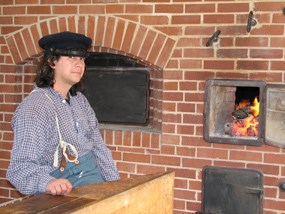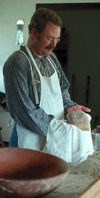
Bread has constituted a staple of our diets for centuries. Modern armies since the time of Louis XIV have made bread a major part of their sustenance, and in eighteenth century France, portable ovens were carried on campaign to facilitate its ample provision. By the mid-nineteenth century scarcely a nation, including the United States, failed to provide bread daily for its soldiers. The importance of proper facilities and training, essential for producing good bread, was well perceived in the upper echelons of the United States Army. As Major General Winfield Scott explained: Bread and soup are the great items of a soldier's diet in every situation: to make them well is an essential part of his instruction. Those great scourges of camp, scurvy and diarrhea, more frequently result from want of skill in cooking than from any other cause whatever. Officers in command, and more immediately, regimental officers, will, therefore, give strict attention to this vital branch of interior economy. For garrisoned troops, the post bakery constituted one means for best implementing such dictums. Role of the Quartermaster's Department Two army bureaus, the Quartermaster Department and the Subsistence Department, jointly administered the construction and supplying of army bakeries. Principally concerned with transportation, supply, and the care of military cemeteries, the Quartermaster Department procured materials for construction and repair of all buildings at army installations, including bake houses. In the bakery, the Quartermaster furnished all brooms, utensils, and furniture authorized, except ovens, and paid fuel expenses whenever bakery requirements exceeded savings from the fuel allowances to the troops otherwise used. So far as the western posts were concerned, vast distances, primitive land routes, and freezing rivers compounded the task of the Quartermaster Department. Only the completion of the transcontinental railroads and subsidiary lines in the 1860s and 1870s obviated these difficulties. The Commanding Officer of each post expected his Quartermaster or the Quartermaster Sergeant to visit the bakery "frequently" to inspect all the materials from which bread was made. Quartermasters were "deemed not instructed" in their duties until they had followed the whole process of converting a barrel of flour into good bread at least one time. Company officers were expected to recognize good from bad bread, but the Army provided no instruction other than referring officers and bakers to information in encyclopedias, few of which would have been available at western posts. How helpful these officers actually were to the bakers is illustrated in the account of unsuccessful baking written by Albert J. Myer, who later established the United States Army Signal Corps and the United States Weather Service. The future general described his disaster as follows: You ought to have seen me one day very sagely teaching my servant how to make bread! I knew about as much about it as you do! So I told him "first, mix a little flour with some water, then, take some Saleratus and mix with it." Well: he did so. Now I began to be ambitious for the mess looked very much like dough, and I thought I would have a "short cake" So I told him to take some lard and stir it up with the rest. Well: he did that & then he put it into a frying pan to bake it. Would you believe it: the thing wouldn't rise!! But there it stayed, sulking and getting flatter and flatter until it settled right down in the pan and turned yellow!! I looked at it and told the man to "poke a fork into it"--I remembered the holes in crackers--but it never stirred, Then I put coals on top of it, then it turned black outside, while the yellow within was beautifully variegated with spots! Then I tried to eat it; but couldn't, I have heard of soda biscuit, this was decidedly alkaline. I dare say very much like one-Heavy! I suppose it would run into bullets like lead! I gave up in disgust; from that day, to the present, I have never essayed breadmaking, but I do when marching succeed in making a queer sort of a wafer out of flour and water--or rather my man does-and it is good to eat. Taken from "I am Already Quite a Texan",
Role of the Subsistence Department More indirectly involved with the function of the post bakery was the Subsistence Department. While construction and equipage fell to the Quartermaster, the Commissary General's Office handled subsistence matters. The Subsistence Department provided the soldier's ration, or expenses for it, and central to the ration was flour for breadmaking. Besides the basic commodity of flour, the Subsistence Department contributed such other necessities as salt and lard. Storage of these properties demanded constant attention, for most were perishable and required the utmost vigilance for their preservation. At all posts, commissary storehouses sheltered the foodstuffs from which the bakeries drew their needs. Nonfood items managed by the Subsistence Department included the bake ovens, built and funded through the Commissary's office, and such lighting apparatus as candles, lamps, and oil for interior building use.

General Information The Post Bakery was almost in constant use because bread was considered to be one of the most important parts of a soldier's diet. Bread was the staple of each meal. A soldier's rations entitled him to 18 ounces of bread per day, and to provide this bread, Quartermasters were instructed to build bakeries with ovens at all permanent posts. So important was the baking of the bread that one surgeon attributed the good health of his troops to a wholesome diet and "particularly to thoroughly baked bread, and no whisky.'' He went on to add that during his experience at military posts he had found badly baked bread and an undue quantity of alcoholic drinks to be the chief originators of the diseases of the digestive organs. The bakers were ordinary soldiers like the company cooks and were assigned to the bakery for two weeks. The soldiers took their turns at baking, just as they did in the mess kitchen. Later in the Nineteenth Century, men would be assigned the task more or less permanently and sometimes have quarters in the bakery building, but this was not common before the Civil War. The bakers being inexperienced, it is no wonder that medical officers complained of bad and sour bread that was unhealthy for the men to eat. Had encyclopedias been available to study, few enlisted men would have been able to read them, so it must have been taken for granted that they had learned what even today is considered an art as children watching their mothers knead bread, a risky conclusion at best. Flour, salt, water, yeast, and molasses were the basic ingredients of military bread in the 1840s. Only stale bread was issued to the soldiers because it was believed that fresh bread caused indigestion and was not healthy. Under normal conditions, one baker excused from all other duty could produce 250 rations of bread per bake; beyond that figure two or more bakers were needed. This was enough to supply a two company post for two days. Each baker could turn out 700 rations daily, if required, and more if provided assistants. Bakers were expected to heat and fuel the ovens, control water temperatures, sift flour, make yeast, sponge, and dough, mold and scale the dough, proof and bake it, and police the premises. Information on this page was taken from the Historic Furnishings Plan for The Bake House by Sally Johnson Ketchum |
Last updated: July 26, 2016

